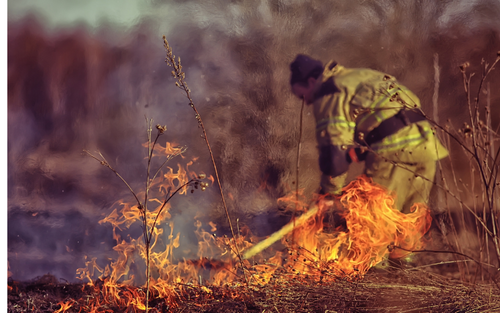10 Ways to Prevent Wildfires
You can prevent wildfires by extinguishing flames before you leave the worksite. Avoid practicing activities that use flames or sparks on windy days or in drought conditions. And maintain your equipment to prevent overheating and engine failure.
Wildfires are becoming increasingly common across the United States due to climate change and rising temperatures. The country experiences an average of 61,410 wildfires per year, with around 7.2 million acres impacted annually. One fire can lead to millions, if not billions, of dollars in destruction while putting countless lives at risk. Professionals and businesses of all types need to do their part to prevent wildfires by extinguishing flames quickly and limiting their impact on the environment.
Now that wildfire season is in full swing, here are 10 ways to prevent wildfires:
- Avoid any activity that involves fire or a spark in dry, windy conditions. Check for drought in the area before beginning work and reschedule the task if necessary.
- Use fire and flames in a wide-open area far away from flammable vegetation. Remove tall grass, dry leaves, and other debris from the worksite to reduce the chances of it catching fire. Douse all fires before leaving and wait for the campsite to go cold. The site should be cold to the touch when it’s safe to leave.
- Gas powered tools such as chain saws, cut-off saws, grinders and concrete saws should all have functional spark arrestors in place.Avoid driving vehicles that use internal combustion on overgrown grass and dry leaves. The catalytic converter (common on most vehicles) can reach temperatures above 1,000 degrees Fahrenheit, so stick to flat lands with limited vegetation where possible.
- Inspect your equipment before and after every use and take it out of rotation if it needs repairs. Mechanical engines and equipment can overheat with excess use. Remember to practice preventative maintenance by supplying the engine with high-quality oil and replacing broken parts to avoid starting a fire.
- Carry fire extinguishing materials on your person if possible, in case of a fire, including a working fire extinguisher, shovel, and a bucket of sand or water. Keep an eye out for sparks and smoke when riding off-road.
- Secure loads when hauling equipment off-road. Ensure the trailer is securely attached to the vehicle and not scraping against the ground or another piece of metal, which can cause a spark. Trailer chains are a particular source of sparks.
- Maintain a radius of anywhere from 10 to 25 feet from vegetation when using fire or equipment that produces a spark. Increase the safe working distance during drought conditions.
- Practice the proper safety procedures when operating equipment in outdoor environments. Follow all safety instructions and do not use equipment for anything other than its intended purpose. Before using the equipment, confirm with the local Bureau of Land Management that it is safe to use in the area to avoid incurring penalties.
- Burn debris with caution and avoid doing so on windy days or in drought-prone areas to prevent the flames from spreading. Ensure that multiple people watch while the fire burns in case it starts to get away from you. Be prepared to extinguish the flames promptly if the weather conditions change.
Preventing wildfires is everyone’s responsibility. We must all do our best to protect our natural resources from accidental fires. Land managers and fire prevention chiefs should continue clearing debris to prevent wildfires, but it's important to note that this kind of work can also increase the risk of a wildfire. Therefore, use caution when operating equipment outdoors near vegetation, to leave it in better condition than when you arrived.
Recent Posts
-
Customizing Gas Detectors: Tailoring Solutions to Fit Your Unique Requirements
In today’s diverse industrial landscape, a one-size-fits-all approach to safety simply doesn’t cu …Jul 3rd 2024 -
10 Ways to Prevent Wildfires
You can prevent wildfires by extinguishing flames before you leave the worksite. Avoid practicing …Jul 1st 2024 -
ANSI/ISEA 138 Safety Gloves: Ensuring Hand Protection
The human hand is an anatomical masterpiece and arguably the greatest tool attached to our bodies …Jun 25th 2024





